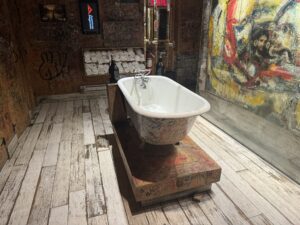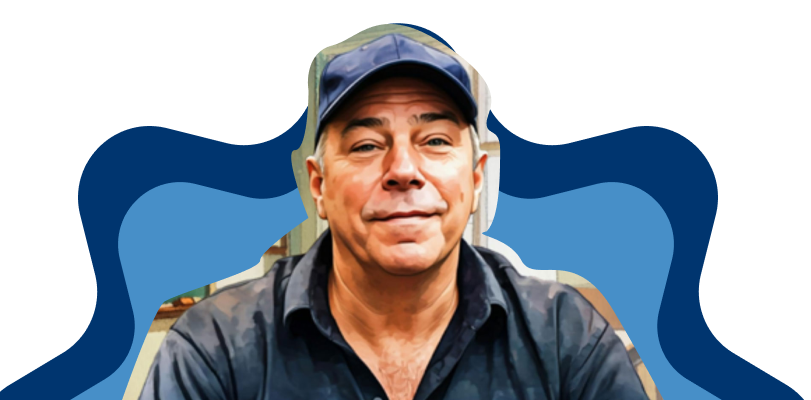Here’s how I managed to narrowly avoid the cracking of my chest:
In the fall of 2011, Elysha and I were having lunch with one of my college friends.
It was the first time I had seen her in a decade. A reunion of sorts that I had been anxiously awaiting.
I was eating clam chowder when an object became lodged in my throat. It wasn’t blocking my airway completely, but it was stuck and causing me to struggle to breathe. Based on what I was eating, I assumed it was a fish bone or a bit of a shell.
I began coughing, first intentionally in an attempt to dislodge the item, then uncontrollably. Then, the coughing became hacking and wheezing. I drank a glass of water in an effort to dislodge it. Then I drank another and another and another.
Still, I coughed and hacked and struggled to breathe.
Eventually, the manager arrived at the table and offered assistance. We were sitting in the middle of the dining room, so my coughing was undoubtedly creating a scene. The manager led me through the dining room (with Elysha in tow) to a closed-off bar area where, before I knew what was happening, one of the waitstaff began administering the Heimlich maneuver on me.
Ironically, Elysha and I had just been re-certified in CPR the day before, so I knew his attempt at this procedure was poorly executed. Since I was coughing and speaking, the Heimlich maneuver should never have been applied in the first place, but the way the man administered it was even worse. He wrapped his arms around my chest and began squeezing, lifting me off my feet as he did. This did nothing for the bone lodged in my throat but hurt like hell and made it even harder to breathe.
Between gasps, I begged for him to stop.
A moment later, an ambulance was called.
The manager led me and Elysha through the kitchen to a loading dock at the back of the restaurant. I initially thought the manager was being helpful, but I soon realized that he was just trying to get me as far away from the other customers as possible and avoid having an ambulance parked in front of the restaurant.
Seconds later, the ambulance arrived. Paramedics placed me on a stretcher and began taking my vital signs. I overheard one whisper to the other that I had “decreased breath sounds on the left side.”
I asked them to either share this information with me or do a better job of whispering because they were freaking me out.
I was loaded into the ambulance. Elysha climbed in alongside me, and we were off.
I was brought to the University of Connecticut Health Center, which was thankfully just a few minutes down the road. Doctors first attempted to use forceps to dislodge or retrieve the object. My throat was sprayed with a numbing agent, four doctors and nurses held me down to counter my gag reflex, and a fifth jammed a set of long, metal forceps down my throat.
It was awful. Painful and frightening and exhausting.
This process continued, off and on, for nearly an hour. I hadn’t vomited since 1983, but I was convinced this procedure would spoil my streak.
Somehow, it did not.
When this failed, a doctor inserted smaller arthroscopic forceps, complete with a camera and clippers, through my nose and down into the throat to remove the object.
It sounds horrifying, and it initially was, but that scope was soon put up my nose and down my throat so often that it became fairly normal. Just a thin, little snake sliding around in my skull.
It was eventually determined that the object was too large to bring back up through my nose, so it was back to the original forceps.
Numbing agents were applied again. More attempts to reach down my throat were made. I was worked on for more than three hours, each doctor older than the next, before it was determined that I would require surgery. Fearful that the object might end up in my lungs if not removed soon, the doctors would make an incision from the top of my throat down to my chest to remove the object.
“Depending on where it’s lodged, we might have to crack the chest,” one doctor explained.
This sounded insane to me. I was going to have my throat cut open and my chest cracked for a fishbone?
With Elysha by my side, they began rolling me from the emergency room to the surgical floor. As they rolled, I began to panic. I couldn’t believe this was happening.
“Stop,” I said.
To their credit, they did.
“Have we tried everything?” I asked. “Take a second and think. Is there anything else we could possibly do before you cut me open? Can we please think outside the box?”
To their credit, everyone was quiet for a moment, and then one of the nurses said, “Well, we’ve never tried to slide the arthroscopic forceps down someone’s throat before.”
“Well,” I said. “Let’s try that.”
Instant excitement swept through the team. If it worked, this would be a new procedure. A new use for a medical instrument. Other doctors were called to observe. Two video cameras – the large, old-fashioned VHS kind – were brought in to record the procedure. About a dozen doctors jammed themselves into a small examination room where the procedure would be attempted, pushing Elysha to the far corner of the room.
Once again, a handful of doctors held me down to counteract my gag reflex as the snake-like device slid down my throat, and a doctor, staring into the eyepiece, poked and prodded. A minute later, the scope was retracted. Trapped in its tiny forceps was a dried bay leaf.
Not a bone or a shell.
Just a leaf, which should have been removed before serving me the chowder but was not.
The room erupted in cheers. For a moment, I was entirely forgotten. I looked across the room, through a crowd of excited doctors, and made eye contact with Elysha. She looked exhausted, but she was smiling.
I spent about six hours at the medical center that day, and though I probably could have sued the restaurant, I did not.
In retrospect, I wish I had.
Nevertheless, I learned something very valuable that day:
There is nothing wrong with questioning your doctor. Had I not stopped that gurney from rolling into the operating room, I would’ve ended up with an incision in my throat or even worse. Panic caused me to stop the doctors that day and ask them to find a different solution, but in the future, it will be the knowledge that I can play an active and potentially helpful role in my medical care.
A doctor informed me that I would likely end up in a medical journal, which did not excite me as much as it seemed to excite him.
It also wouldn’t be the last time I became a subject in a medical journal. Years later, when canine scabies managed to burrow under my skin – something doctors had never seen before in a human being – a professional photographer was called into the dermatologist’s office to take photographs of my forearms for an eventual medical journal article.
Such is my life.
For the record, I never saw my college friend again. Once I left the table for the bar area and loading dock and ambulance, I lost track of her, and we never spoke again.
Such is my life.








